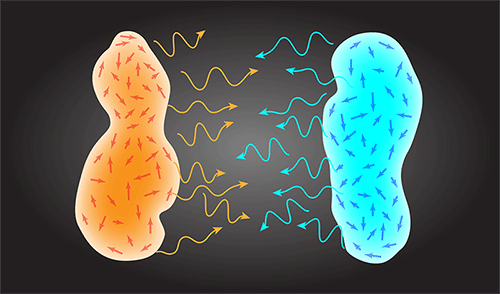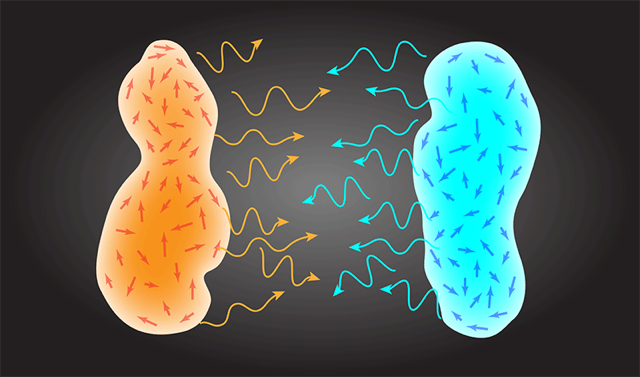Sharing Heat in the Near Field
Two separated objects at different temperatures will exchange heat, even when immersed in vacuum. This radiative heat transfer is mediated by photons and is the basis for the heating of our planet by the Sun and certain types of high-resolution optical microscopy [1]. The theory for radiative heat transfer, first developed in the 19th century, is well established. But theoretical efforts have mainly focused on the far-field limit, where objects are separated by distances larger than the thermal wavelength, 𝜆=ℏc∕kBT—about 8 micrometers at room temperature. Understanding the process at shorter distances, the near field, is of growing technological interest, as researchers are increasingly able to make mechanical and computational machinery with micro- and nanometer-sized components. Owen Miller from the Massachusetts Institute of Technology, Cambridge, and colleagues have now derived an equation that can be used to calculate the maximum amount of radiative heat one object can transfer to another (Fig. 1) in the near field [2]. This equation is general and applies to arbitrary shapes—a significant advance over previous work. It might therefore be used to find the optimal shapes and materials for elements in devices whose operation depends on heat transfer.
Derived in the late 1800s, the Stefan-Boltzmann law gives a mathematical expression for the maximum amount of heat, per unit area, one body can absorb from another in the far field. Known as the blackbody limit, this maximum depends only on the two bodies’ temperatures and can only be reached in the idealized case that the two bodies absorb all the radiation impinging on them. When objects are close together, however, the Stefan-Boltzmann law breaks down, and the heat flux can be many orders of magnitude greater than the blackbody limit [3]. The main reason is that at such distances surface (evanescent) waves can tunnel between the two bodies [4]. Although there has been strong interest in understanding near-field effects for several decades, there has been no general expression for the maximum heat flux that could be transferred from one arbitrarily shaped object to another in the near field.
The authors tackled this fundamental problem using a model that describes radiative heat transfer as originating from fluctuating electrical currents within the two bodies. Such currents result from electrical dipoles whose values vary because of both thermal and quantum fluctuations. Starting with this description, Miller and colleagues added two further constraints: energy conservation and the reciprocity theorem of optics. The former principle limits the amount of energy one body can absorb; the latter allows each body to be treated as either a source or a receiver, so the final heat-transfer expression is symmetric with respect to the two bodies. With this approach, the authors derived a concise, general, and simple equation that can be used to calculate the upper bound for the heat transfer, per unit area, between two bodies.
Remarkably, the equation applies to any pair of bodies, regardless of their shape; it depends only on the distance between the objects and their response (susceptibility) to an external impinging field. The distance dependence has a simple explanation. Any object, regardless of its shape, can, to a first approximation, be constructed from point-like dipoles that are small compared to the dominant thermal wavelengths. And since the heat exchanged between two dipoles in free space has an upper bound that depends only on distance, the heat exchanged between two bodies constructed from dipoles will also be bounded.
The authors also derived an equation that can be used to calculate the upper bound for heat transfer between specific geometries. This result could help researchers design sources that are optimized for radiative heat transfer. They examined a few illustrative scenarios. For example, they showed that the heat flux between two spheres or between a sphere and a plane could reach values close to the calculated theoretical upper bound. In contrast, the energy exchange between two flat parallel planes—the objects typically considered in theoretical work—rarely approaches this theoretical limit. This is because two planes are, geometrically, least like the ideal case of two dipoles. Destructive interference of currents is more likely in extended objects like planes than in other structures, and is the limiting factor for heat transfer, regardless of the material out of which the objects are made.
As a further example, the authors considered a pair of planar arrays of oblate disks, each small enough to be described as a dipole. Compared to any other pair of extended sources, this configuration shows an order-of-magnitude enhancement in the amount of heat exchanged, and comes close to the near-field limit. Moreover, Miller and colleagues showed that extended structures approaching the near-field limit can produce a radiative heat flux that surpasses the conductive heat exchange between the same bodies when separated by air. This finding could be relevant for scanning thermal microscopy and atomic force microscopy experiments that have recently been used to measure radiative heat transfer. These techniques have always been performed in vacuum to avoid the conduction between the sample and the scanning probe, as this heating mechanism was assumed to dominate the radiative one. The authors’ work shows this may not be the case for some configurations.
Although limits to near-field radiative heat transfer have been calculated before [5, 6], they only applied to the specific case of two flat surfaces separated by a gap or were based on the assumption that there was a cut-off frequency limiting the energy exchange. The more general approach followed by Miller and colleagues, which applies to arbitrary shapes, shows that previously obtained limits were either too weak or too strong.
The theoretical expression derived by Miller and colleagues should be relevant for numerous applications. These include thermal management at the nanoscale, sensitive IR sensors and spectroscopy [1, 7], and heating-assisted data storage [8]. The author’s equation also gives the contribution to the flux coming from each frequency, showing, for example, that most of the transferred flux in the oblate-disk arrangement comes from one frequency band. Further studies of this spectral dependence could lead to ways of tailoring the amplification of heat flux between objects in a particular narrow window of frequencies. This capability would significantly boost the efficiency of near-field thermophotovoltaic devices, a recently introduced means of converting heat into electric current [9].
This research is published in Physical Review Letters.
References
- A. C. Jones and M. B. Raschke, “Thermal Infrared Near-Field Spectroscopy,” Nano Lett. 12, 1475 (2012).
- O. D. Miller, S. G. Johnson, and A. W. Rodriguez, “Shape-Independent Limits to Near-Field Radiative Heat Transfer,” Phys. Rev. Lett. 115, 204302 (2015).
- D. Polder and M. Van Hove, “Theory of Radiative Heat Transfer between Closely Spaced Bodies,” Phys. Rev. B 4, 3303 (1971).
- K. Joulain, J.-P. Mulet, F. Marquier, R. Carminati, and J.-J. Greffet, “Surface Electromagnetic Waves Thermally Excited: Radiative Heat Transfer, Coherence Properties and Casimir Forces Revisited in the Near Field,” Surf. Sci. Rep. 57, 59 (2005).
- J. B. Pendry, “Radiative Exchange of Heat Between Nanostructures,” J. Phys. Cond. Matt. 11, 6621 (1999).
- P. Ben-Abdallah and K. Joulain, “Fundamental Limits for Noncontact Transfers Between Two Bodies,” Phys. Rev. B 82, 121419 (2010).
- Y. De Wilde, F. Formanek, R. Carminati, B. Gralak, P.-A. Lemoine, K. Joulain, J.-P. Mulet, Y. Chen, and J.-J. Greffet, “Thermal Radiation Scanning Tunnelling Microscopy,” Nature 444, 740 (2006).
- W. Srituravanich, N. Fang, C. Sun, Q. Luo, and X. Zhang, “Plasmonic Nanolithography,” Nano Lett. 4, 1085 (2004).
- S. Basu, Z. M. Zhang, and C. J. Fu, “Review of Near-Field Thermal Radiation and its Application to Energy Conversion,” Int. J. Energy Res. 33, 1203 (2009).





